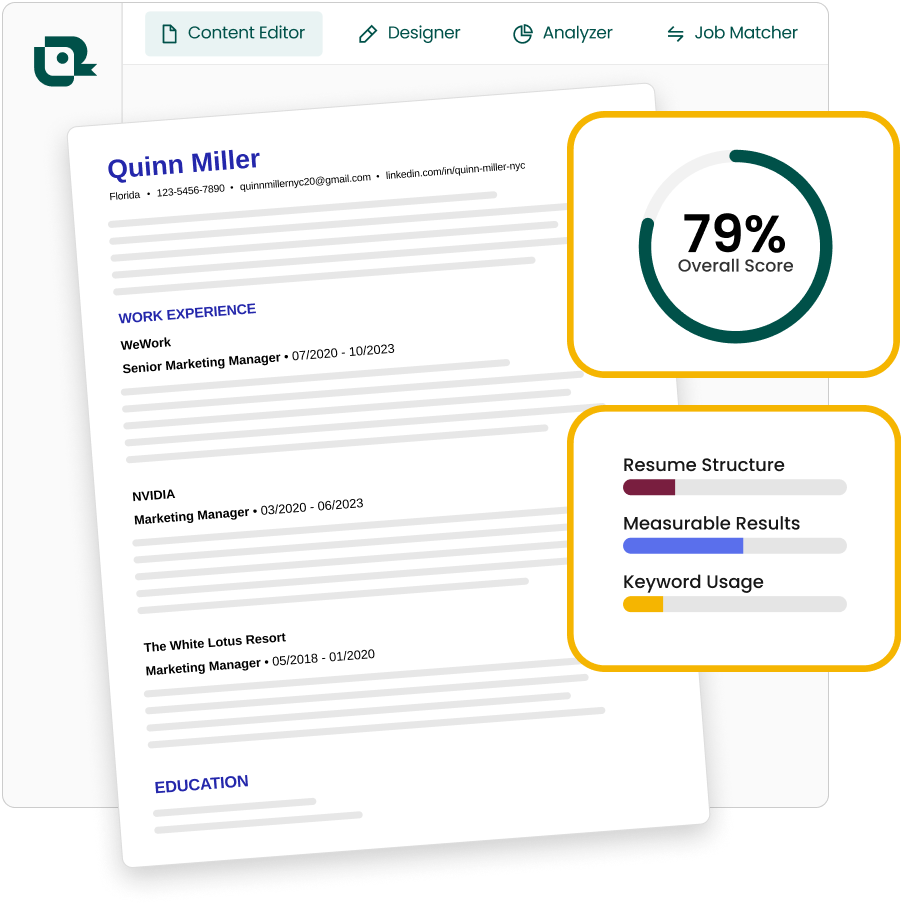3 key takeaways
- To write a career change resume, start by reframing your experience to highlight transferable skills that align with your new career path.
- Then, decide on the right resume format (like a hybrid layout) to lead with what’s most relevant.
- After that? Structure your resume for clarity and impact with clean formatting, consistent styling, and ATS-friendly design.
A strong career change resume doesn’t just list your experience, it tells the story of how your skills translate to something new.
In this guide—written by someone who’s successfully changed careers—you’ll learn how to write a resume that highlights your potential, not just your past. You’ll get tips for framing your resume work experience, emphasizing transferable skills, and structuring your content in a way that connects the dots for hiring managers. Plus, you’ll see real examples of career change resumes that work.
What is a career change resume?
A career change resume is a resume that highlights transferable skills, relevant experience, and potential (rather than relying solely on past job titles) to show your fit for a new role, industry, or function.
When and why you need one
You’ll want to use a career change resume any time your experience doesn’t clearly align with your next move—whether you’re switching careers entirely, changing industries, reentering the workforce after a resume gap, or shifting into a new function.
In these situations, a standard resume can undersell your value. A career transition resume reframes your background so hiring managers can quickly connect the dots—and see why you're a fit, even if your past roles don’t line up one-to-one.
How to write a career change resume (step-by-step)
In this section, we’ll walk through each step of the writing process—from reframing your experience to tailoring your content—so you can confidently position your background for something new. First, pick your format. Then, follow these steps.
Step 1: Reframe your experience
Before you start writing, get clear on what parts of your background are most relevant to the role you’re targeting. This isn’t about rewriting your entire career, it’s about reframing previous jobs to support where you’re going next.
Look for:
- Transferable skills (soft skills) that match the job description
- Key achievements that show impact across roles
- Past experience (even older) that aligns with your new direction
Once you know what to emphasize, you can structure your resume in a way that leads with your strongest, most relevant details. But more on formatting later.
💡Pro Tip: If you’re writing a resume with multiple positions at the same company, list promotions clearly to show growth and adaptability.
Step 2: Add a summary that showcases your career pivot
Your resume summary is one of the first things hiring managers see and for career changers, it’s a critical opportunity to connect the dots.
Use this short section at the top of your resume to frame your background, highlight transferable skills, and signal how your experience aligns with the role. Instead of recapping your entire career, focus on what makes you a strong fit for this new direction. Here's an example of what that can look like:
💡 Pro Tip: Thinking about including a resume objective? Skip it. Employers already know you want the new job. Use your summary to show how you’re qualified—not just that you’re interested.
Step 3. Emphasize transferable skills
According to a study by the American Institute for Economic Research, transferable skills are among the most important factors in successfully changing careers. Why? Because they show employers what you can do—not just where you’ve been. Here’s how to make them work harder on your resume:
- Identify relevant skills from your past roles that align with your target industry. Think: communication skills, leadership, project management, customer experience, or data analysis.
- Use job postings to prioritize which skills to feature—and tailor your language to match.
- Show how you’ve applied those skills in real situations. Use bullet points to emphasize outcomes, not just responsibilities.
- Don’t bury your best assets—make sure they’re woven into your summary, work history, and skills section.
If you find yourself struggling to emphasize your skills for a career change, you're not alone. Most either lean too heavily on past job titles or overstuff the skills section without context. The key is balance: highlight what’s relevant to your next role, not just what you’ve done.
Teal’s Resume Builder helps you do exactly that without having to manually comb through job descriptions. Use it to understand how your experience aligns with every unique job. Then, get phrasing and keywords that match the new field to rewrite your resume with clarity and confidence.
Step 4. Showcase relevant experience and achievements
Your past roles might not match the job title you’re applying for—but the impact you've made still matters.
Use your work experience section to highlight relevant accomplishments that show how you’ve solved problems, led initiatives, or driven results.
Focus each resume bullet point on outcomes, not responsibilities. Here's a formula to help:

Step 5. Include projects, volunteer work, or certifications
If you’re making a career change with little or no direct experience, projects and non-traditional work can help bridge the gap. Including volunteer experience, relevant certifications, or freelance work on a resume shows employers you’re actively building the skills needed for your next role.
Not sure what counts? Think about:
- Freelance work (even short-term or self-initiated) that reflects your target role’s responsibilities.
- Volunteer roles that highlight leadership, communication, or technical skills in action.
- Certifications or coursework that demonstrate your commitment to learning a new field.
- Past internships—especially if you’re pivoting early in your career or reentering the workforce. (You can list an internship on your resume just like a paid job if it’s relevant.)
Step 6: Customize your content for every job
Customizing your resume for each role shows hiring managers that you understand what they’re looking for and can meet their needs, even if your background looks a little different. Here's how:
- Look closely at the job description and identify the keywords, qualifications, and themes that come up most.
- Then, reflect those in your summary, bullet points, and skills section—using language that mirrors what the company values.
Tailoring your career change resume helps clarify your fit, increases your chances of standing out, and ensures your resume is easier to find in applicant tracking systems (ATS).
What a career change resume should look like in 2025
Even if your experience isn’t traditional, your resume still should be. Clean formatting, clear sections, and a structure that prioritizes relevance over chronology can help hiring managers quickly understand your value.
In this section, you’ll learn what a strong career change resume should look like in 2025 and how to choose the right format and layout details that make your experience easier to scan.

Format
The best resume format for a career change is typically a combination (or hybrid) resume.
This structure leads with skills and qualifications, then follows with a streamlined work history—making it easier to highlight transferable strengths while still showing career progression.
A functional resume, which groups experience by skill category and downplays job titles and dates, is another option, but it’s less common and can raise questions for hiring managers. If you go this route, use it strategically and be ready to explain your career path in a cover letter and interview.
📌 Resume Myth: All career change resumes should use a functional format
While a functional resume can be useful in a few scenarios, it's not the default.
A chronological resume (or hybrid model) can absolutely work for a career change—as long as the experience you list is relevant to your new field or industry. The key isn’t hiding your timeline—it’s highlighting what aligns.
Visual layout
A strong career change resume doesn’t need to be flashy, it just needs to be easy to read.
Keep your layout clean, modern, and consistent. Use one professional font, stick to a single accent color (if any), and make sure there’s enough white space between sections to guide the reader’s eye.
Here’s what to focus on:
- Use clear headings for each section (like “Summary,” “Work Experience,” and “Skills”)
- Align your dates to the same side for every entry
- Use resume bullet points for readability—never paragraphs
- Avoid unnecessary graphics, icons, or design elements that might confuse ATS software
💡 Pro Tip: Consistency matters. Recruiters notice when dates jump around or formatting changes from section to section. Make sure your job titles, companies, and dates are all styled the same way.
Career change resume examples
Seeing how others have successfully navigated a career pivot can make it easier to visualize your own. Below are two career change resume examples—each one tailored to a new direction, with transferable skills and relevant experience brought to the forefront.
These examples follow a clean, modern layout and use formatting that’s easy to scan and ATS-friendly.
Career change example #1: Marketing to product management
This resume highlights a transition from content marketing to product management. The candidate led cross-functional projects, collaborated closely with engineering teams, and used data to inform strategy—experience reframed to match PM expectations.
✅ What stands out:
- A summary focused on business impact and collaboration
- Bullet points that emphasize ownership, outcomes, and cross-team communication
- A skills section tailored toward product-focused tools and frameworks

Career change example #2: Design to developer
In this example, the candidate is changing careers from a visual design role into front-end development. They showcased freelance projects and technical coursework while reframing past achievements to focus on problem-solving and user experience.
✅ What stands out:
- A clear target title and summary aligned with engineering roles
- A “Projects” section highlighting real development work
- Technical skills surfaced above the fold to boost relevance

Build a resume that supports your next move
Making a career change isn’t about starting from scratch—it’s about reframing what you’ve already done to support where you’re headed. When your resume leads with transferable skills, relevant achievements, and clear alignment with the role, hiring managers don’t have to guess why you’re a fit. Your next role may be new, but the experience that gets you there is already yours. Build a resume that shows it.

Frequently Asked Questions
What is the best resume format for a career change?
The best resume format for a career change is a combination resume. It allows you to highlight transferable skills and key achievements at the top while still showing your work history in a clear, chronological order.
How do I explain a career change on a resume?
Explain a career change on a resume by using your summary section to connect your past experience to your new goals. Focus on the skills and accomplishments that translate to the role you’re targeting.
How do I write a career change resume with no experience?
Write a career change resume with no experience by emphasizing transferable skills, relevant projects, volunteer work, and certifications. Use your summary to show your potential and tailor every section to what the new role requires.








